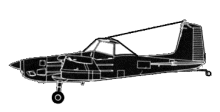
ASN Wikibase Occurrence # 298449
This information is added by users of ASN. Neither ASN nor the Flight Safety Foundation are responsible for the completeness or correctness of this information.
If you feel this information is incomplete or incorrect, you can submit corrected information.
| Date: | Thursday 27 September 2001 |
| Time: | 08:05 LT |
| Type: |  Cessna T188C |
| Owner/operator: | Addison Spraying Service |
| Registration: | N4629J |
| MSN: | t18803757T |
| Year of manufacture: | 1980 |
| Engine model: | Continental TSIO-520-T |
| Fatalities: | Fatalities: 0 / Occupants: 1 |
| Aircraft damage: | Substantial |
| Category: | Accident |
| Location: | Aiken, Texas -
 United States of America United States of America
|
| Phase: | Unknown |
| Nature: | Agricultural |
| Departure airport: | Plainview-Hale County Airport, TX (PVW/KPVW) |
| Investigating agency: | NTSB |
| Confidence Rating: |
The pilot was maneuvering the agricultural airplane to enter a field and commence spraying, when at 120 feet agl, the engine lost power. The pilot attempted to restart the engine; however, the engine did not restart. During the ensuing forced landing, the airplane contacted circular rows of cotton, before coming to rest upright. The engine was examined at the manufacturer's facility and silicon sealant was observed on the base flanges of the #1, #2, #4, and #6 cylinders and on the crankcase mating surfaces. Fretting was observed on the base flanges of the cylinders, on the mating surface of the crankcase halves, and on the main bearing bosses. The #2 main bearing was observed fragmented and the bearing's bore was cracked and damaged. Additionally, it was observed that the crankshaft was fractured between the #2 main bearing and #3 crankshaft cheek. According to a TCM metallurgist, the fatigue fracture's origin was determined to be at the aft radius of the #2 main bearing. The silicon sealant prevented proper torqueing of the bolts that mate the crankcase halves and led to vibration at the crankcase mating surfaces. The #2 main bearing then shifted and failed, resulting in a loss of engine power.
Probable Cause: the application of silicon sealant to the crankcase mating surfaces by maintenance personnel, which resulted in improper torque on the bolts which mate the crankcase halves, vibration, and the subsequent failure of the #2 main crankshaft bearing. A factor was the lack of suitable terrain for the forced landing.
Accident investigation:
 |
|
Sources:
NTSB FTW01LA210
Revision history:
| Date/time | Contributor | Updates |
|---|---|---|
| 15-Oct-2022 18:10 | ASN Update Bot | Added |
Corrections or additions? ... Edit this accident description
The Aviation Safety Network is an exclusive service provided by:


 ©2024 Flight Safety Foundation
©2024 Flight Safety Foundation